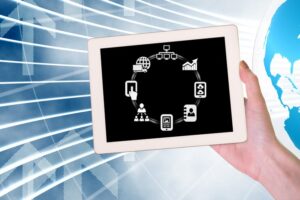Introduction
Information Technology (IT) has become the backbone of modern civilization, driving advancements across industries, enhancing communication, and redefining the way people interact with the world. The rapid growth of IT has led to significant improvements in efficiency, connectivity, and accessibility. This article explores the evolution of IT, its impact on various sectors, and the future trends shaping the digital landscape.
The Evolution of Information Technology

The Early Days of Computing
The foundation of IT can be traced back to the early 20th century with the invention of the first mechanical computers. Devices such as the ENIAC and UNIVAC laid the groundwork for modern computing, enabling the processing of complex calculations.
The Rise of Personal Computing
The 1970s and 1980s marked a revolution in IT with the introduction of personal computers (PCs) by companies like Apple and IBM. This era made computing accessible to individuals and businesses, increasing productivity and driving innovation.
The Internet Boom
The advent of the internet in the 1990s transformed IT, connecting people and businesses worldwide. The rise of email, websites, and e-commerce paved the way for a new digital economy.
Cloud Computing and Mobile Technology
The 21st century has seen an explosion of cloud computing and mobile technology. Companies like Amazon, Google, and Microsoft have developed cloud platforms that enable businesses to store and access data remotely, reducing the need for physical infrastructure. Meanwhile, smartphones have revolutionized communication and access to information.
Artificial Intelligence and Big Data
With advancements in artificial intelligence (AI) and big data analytics, IT is now capable of processing vast amounts of information, enabling predictive analysis, automation, and decision-making at an unprecedented scale.
The Impact of Information Technology on Various Sectors

Healthcare
IT has revolutionized healthcare by enabling electronic health records (EHRs), telemedicine, and AI-driven diagnostics. Medical professionals can now access patient data in real-time, improving diagnosis and treatment outcomes.
Education
Technology has transformed education through e-learning platforms, virtual classrooms, and AI-driven tutoring systems. Students can now access educational materials from anywhere in the world, making learning more inclusive and personalized.
Finance and Banking
The financial sector relies heavily on IT for digital banking, secure transactions, and fraud detection. Technologies like blockchain and fintech applications are reshaping the way people manage and transfer money.
Business and E-Commerce
IT enables businesses to operate more efficiently through enterprise resource planning (ERP) systems, customer relationship management (CRM) software, and automation. E-commerce platforms like Amazon and Alibaba have transformed global trade, allowing businesses to reach customers worldwide.
Cybersecurity and Data Protection
With the rise of cyber threats, IT plays a crucial role in ensuring data security. Organizations invest in encryption, firewalls, and cybersecurity measures to protect sensitive information from cyber-attacks.
Transportation and Logistics
IT has enhanced logistics through GPS tracking, automated warehouses, and AI-driven supply chain management. Companies like FedEx and Amazon leverage IT to optimize delivery routes and inventory management.
Also Read:
Artificial Intelligence: The Evolution, Impact, and Future of AI
Latest Political News in the USA Today
Future Trends in Information Technology

The Expansion of Artificial Intelligence
AI is expected to further integrate into IT systems, automating tasks, improving customer experiences, and driving innovation across industries.
The Growth of 5G and IoT
The rollout of 5G networks will enhance internet speed and connectivity, enabling the Internet of Things (IoT) to flourish. Smart cities, connected homes, and autonomous vehicles will become more prevalent.
Quantum Computing
Quantum computing has the potential to solve complex problems beyond the capabilities of classical computers. Companies like IBM and Google are investing heavily in this emerging technology.
Enhanced Cybersecurity Measures
As cyber threats evolve, IT security will continue to advance with AI-driven threat detection, blockchain security applications, and improved encryption techniques.
Remote Work and Virtual Collaboration
The shift to remote work has increased the demand for IT solutions that support virtual collaboration. Cloud-based tools, video conferencing software, and cybersecurity measures will continue to evolve.
Conclusion
Information Technology has profoundly shaped modern society, transforming industries and improving daily life. As technology continues to advance, IT will remain a driving force behind innovation and progress. However, with these advancements come challenges such as cybersecurity threats and ethical considerations. The future of IT will depend on how well society balances innovation with security, accessibility, and ethical responsibility.